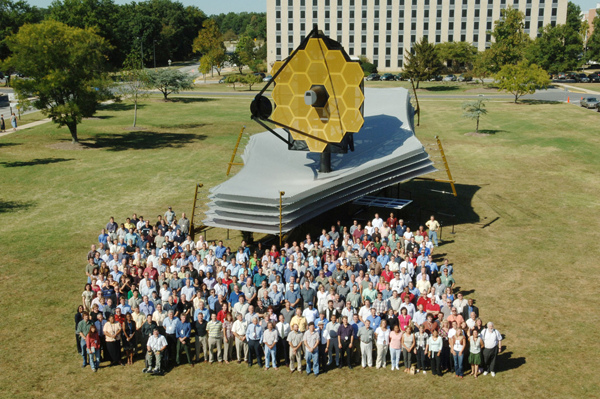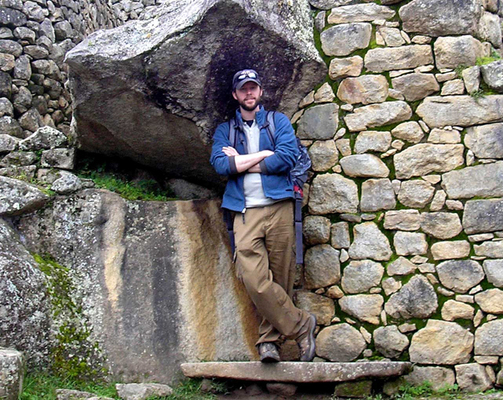
by Timothy Oleson Thursday, January 5, 2012

A full-scale replica of the James Webb Space Telescope sits outside the NASA Goddard Space Flight Center in Greenbelt, Md. NASA

Timothy Oleson at Machu Picchu in Peru. courtesy of Dave Clark
Perhaps you have heard of the psychological principle of entrapment. In college, a friend of mine once described it to me while we stood in a seemingly endless line in one of the dining halls. As I recall, the essence of it is that the more money, time or effort you invest in some venture waiting for a return — a sandwich in my case — the harder it is to simply let it go or give up hope, regardless of how unfavorable the potential cost-benefit ratio is. At the time, I remember thinking that my friend, a budding behavioral psychologist, was merely re-packaging a bit of common sense as some trumped-up, pseudo-scientific axiom. Bullheaded, I scoffed and left the sandwich line, mainly to irritate him, but also to prove that I was not so easily ruled by outside forces.
This memory came back to me the other day after reading about the sudden flare-up in the debate over the fate of NASA’s next-big-thing, the James Webb Space Telescope (JWST). (Sandwiches and space telescopes make for a strange comparison I realize.)
Generally perceived as the successor to the aging Hubble Space Telescope, JWST is a physically massive piece of equipment as well as a massive technological achievement. Whereas Hubble was designed largely to observe in the visible light spectrum from a low-Earth orbit, JWST is intended to detect infrared radiation while actually orbiting the sun in synchronicity with Earth at an astonishing 1.5 million kilometers from the planet (nearly four times the distance between Earth and the moon). These traits will allow it to detect distant celestial objects like dust clouds and galaxies that emit infrared radiation, but little to no visible light, while simultaneously minimizing infrared interference given off by the sun, Earth and the moon that would otherwise act to obscure the distant signals.
The JWST project has been under scrutiny in recent months, though, for being well over-budget and behind schedule. Originally, the project was expected to cost about $1.6 billion and was to launch in 2011. More recently, estimates were closer to $5 billion with a projected 2014 launch. With such a ballooning budget, even supporters of the project, such as Sen. Barbara Mikulski, D-Md., have voiced concerns.
Last fall, Mikulski called for independent review into the overruns and delays. The resulting report by the Independent Comprehensive Review Panel concluded that the total cost of the project would likely fall between $6.2 billion and $6.8 billion, and that telescope would be ready for launch no sooner than September 2015. (NASA itself is now targeting a 2018 launch.) The new numbers do not paint a pretty picture.
Last week, members of the House Subcommittee on Commerce, Justice, Science and Related Agencies, which is part of the House Appropriations Committee, evidently had had enough. In its draft spending bill for fiscal year 2012, the subcommittee proposed cutting $1.6 billion from NASA’s overall budget compared to 2011, and explicitly called for the JWST project to be terminated. Today the full House Appropriations Committee is scheduled to consider the draft bill.
Over the past week, scientific organizations, including NASA and the American Astronomical Society have voiced their support for the JWST. Hopefully, the committee members have heard the loud outcry. And hopefully, they will see fit to abandon the proposed termination.
The problem, as I see it, is that we’re trapped, courtesy of that darn entrapment principle.
For one thing, a great deal of taxpayer money — reportedly $3 billion (link 1, 2) — has already been spent in the decade or so since construction on JWST began. Much of this would be considered wasted money if the project is terminated. Financially, if the $6-billion-plus projection holds, we stand to lose about as much if we cancel it now as we will spend to complete it. Additionally, cancelling JWST would mean leaving international colleagues at the European Space Agency and the Canadian Space Agency, who have been collaborating on JWST, in a bind, after they too have invested in the project.
Furthermore, the situation with JWST seems to be paralleling that of Hubble, which itself was plagued by pre-launch delays and budget overruns that finally amounted to a $4.7 billion price tag (in fiscal year 2010 dollars). As others have pointed out, however, the tremendous wealth of images and insights that Hubble has generated in the last 20 years, and continues to generate, now seems more than worth that cost.
We’re also trapped from a scientific and technical standpoint. As the independent review and others have noted, most of the big questions that astronomers have laid out as priorities in coming years require JWST’s capabilities to address. If deployed, the telescope is expected to peer far back in time at the early formation of stars and galaxies, and potentially to uncover the mysteries of dark matter and other phenomena. Since there are no competing or comparable instruments in development, canceling the project would no doubt be a significant setback to these research goals.
Following the end of the space shuttle program, NASA is set to refocus its energy more on unmanned exploration and science, and the JWST is a centerpiece of this effort. Cutting funding for it suddenly would thus limit the agency’s ability to fulfill its mandated mission.
The good news with the project, according to the independent review, is that “The problems causing cost growth and schedule delays on the JWST Project are associated with budgeting and program management, not technical performance. The technical performance on the Project has been commendable and often excellent.” In other words, the telescope is no pipe dream. It can be finished successfully. And with the spectacular scientific results that we can expect, maybe sticking it out with Webb and giving into entrapment is not so bad after all. Beyond that, though, we’ve simply invested too much money, time and effort in it to be bullheaded and back out now.
© 2008-2021. All rights reserved. Any copying, redistribution or retransmission of any of the contents of this service without the expressed written permission of the American Geosciences Institute is expressly prohibited. Click here for all copyright requests.